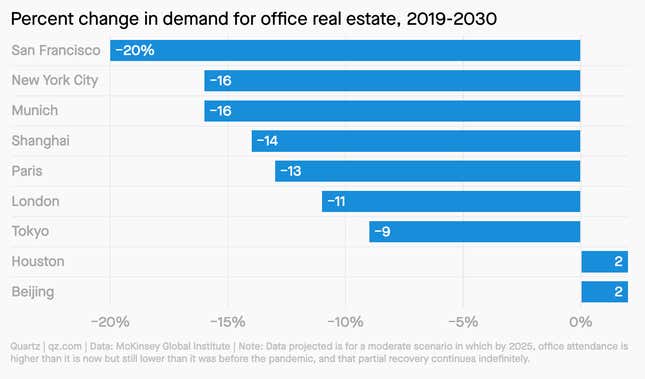Hello, Quartz at Work readers!
Click around for long enough across the internet, and you might come across a specific kind of satire—one aimed at all the digital tools we use to work. Product designers present new (and fake) features for our inboxes, meetings, and watercooler chats, all in the name of poking fun at workplace norms. Take, for example:
🎯 The made-up meeting punctuality score, which projects who’ll show up to the brainstorm 10 minutes late
👶 Or the imagined LinkedIn nepotism disclosure, which labels which manager is actually just related to the boss
💸 And the spoof Google Calendar price assistant, which shows the cost of that meeting that should probably just be an email
These ideas have existed solely as parody—at least until now. That last one is no longer fiction at e-commerce company Shopify, which is rolling out a real meeting cost calculator inside its calendars.
Now when employees propose a group brainstorm session or project debrief, a calendar integration will look at the meeting’s length and invitees—and put a price tag on it. The goal: Discourage excessive meeting culture by showing what they really cost everyone.
“For us, the dollar value is not the point,” Shopify chief operating officer Kaz Nejatian tells Quartz. The tool is meant to nudge teams to reconsider whether they really need that stale team stand-up—and find more creative ways to collaborate with their time.
In fact, the cost calculator is just the latest way Shopify has been pushing against pointless meetings. Earlier this year, the company canceled 12,000 recurring meetings on employee calendars in a test to make employees rethink which gatherings were useful.
So should your team be measuring your meetings in cash value, too? Shopify’s trial makes its case. Find the payoffs inside Quartz’s story.
ZOOM THROUGH THIS MEETING PROPOSAL
But why stop at cost calculators? Our newsroom rounded up its own pitches for ways to fix time-wasting meetings. Among our ideas:
🦈 Brainstorm boat-rockers. For virtual meetings prone to going overtime, the speaker gets a background that looks like a shark is chasing them. They need to complete their thought within 30 seconds, or they get Jaws’ed.
🔥 Stand-up survival. Everyone on Zoom gets a digital torch and an allotted speaking time. When you’ve used yours up, Jeff Probst joins the meeting to extinguish your flame. The tribe has spoken.
🎻 Award-winning conclusions. At the scheduled end time, swelling orchestral music plays over the speakers, eventually so loud that it’s the only thing anyone can hear.
Now we want to hear from you: What tools would you invent to end your workplace woes? Hit us with your best suggestions.
OFFICE BUILDINGS ARE FEELING THE SQUEEZE
$800 billion: The value that remote work is poised to wipe out in global offices by 2030. And that’s just the moderate projection.
Being able to work flexibly—whether that’s remotely, or on a hybrid schedule that mixes in-person and at-home time—has transformed how people relate to their jobs. But it’s also changed spaces in the world’s biggest urban centers, leaving global offices with a lot of unwanted space.

Now a new report puts a price on how remote work is dropping real estate prices in nine of the world’s most powerful cities. While you may be tempted to take out a tiny violin for big brokers’ profit margins, those numbers don’t just impact the property books—they also threaten global cities more widely.
📉 Quartz’s Clarisa Diaz and Gabriela Riccardi dig into just how steep the fallout could be—and what it means for remote work’s remaking of urban spaces.
US CONSERVATIVES COME FOR CORPORATE DIVERSITY
“The Supreme Court’s recent decision should place every employer and contractor on notice of the illegality of racial quotas and race-based preferences in employment and contracting practices.”
That’s from 13 US Republican attorneys general, who last week issued a joint letter aiming to interfere in companies’ hiring policies. Their message: The court’s decision to strike down affirmative action in college admissions is reason enough to end similar programs in the workplace, too.
In actuality, the affirmative action ruling does not actually affect corporate DEI programs. But as advocates have warned, conservative litigators are looking to get the rulings applied to office diversity initiatives next. Quartz’s Julia Malleck covers which companies they’re coming for first.
YOUR WEEKLY WORK HACK
“Rust-out” can signal that you’re ready for career growth. As opposed to burnout, rust-out is when we feel understimulated and underutilized, career coach Kelli Thompson explains in Quartz.
“In my banking role, I constantly felt tired and demotivated, despite the relatively low demands of my position,” she writes. Instead of becoming exhausted by doing too much, she adds, we can also be drained by doing too little.
💼 If that’s you, it may be the time to pitch a promotion—or find a challenge elsewhere. Thompson offers four steps to be sure of what kind of change you’re ready for.
QUARTZ AT WORK’S TOP STORIES
🤖 The economic case for slowing down AI
🤝 This 90-minute exercise helps improve cross-team collaboration
💼 5 ways AI can automate managerial tasks
🧶 How to increase clarity and accountability at the office
💰 If you want fewer meetings, measure them in cash
YOU GOT THE MEMO
Send questions, comments, and requiems for rust-out to talk@qz.com. This edition of The Memo was produced by Gabriela Riccardi.
